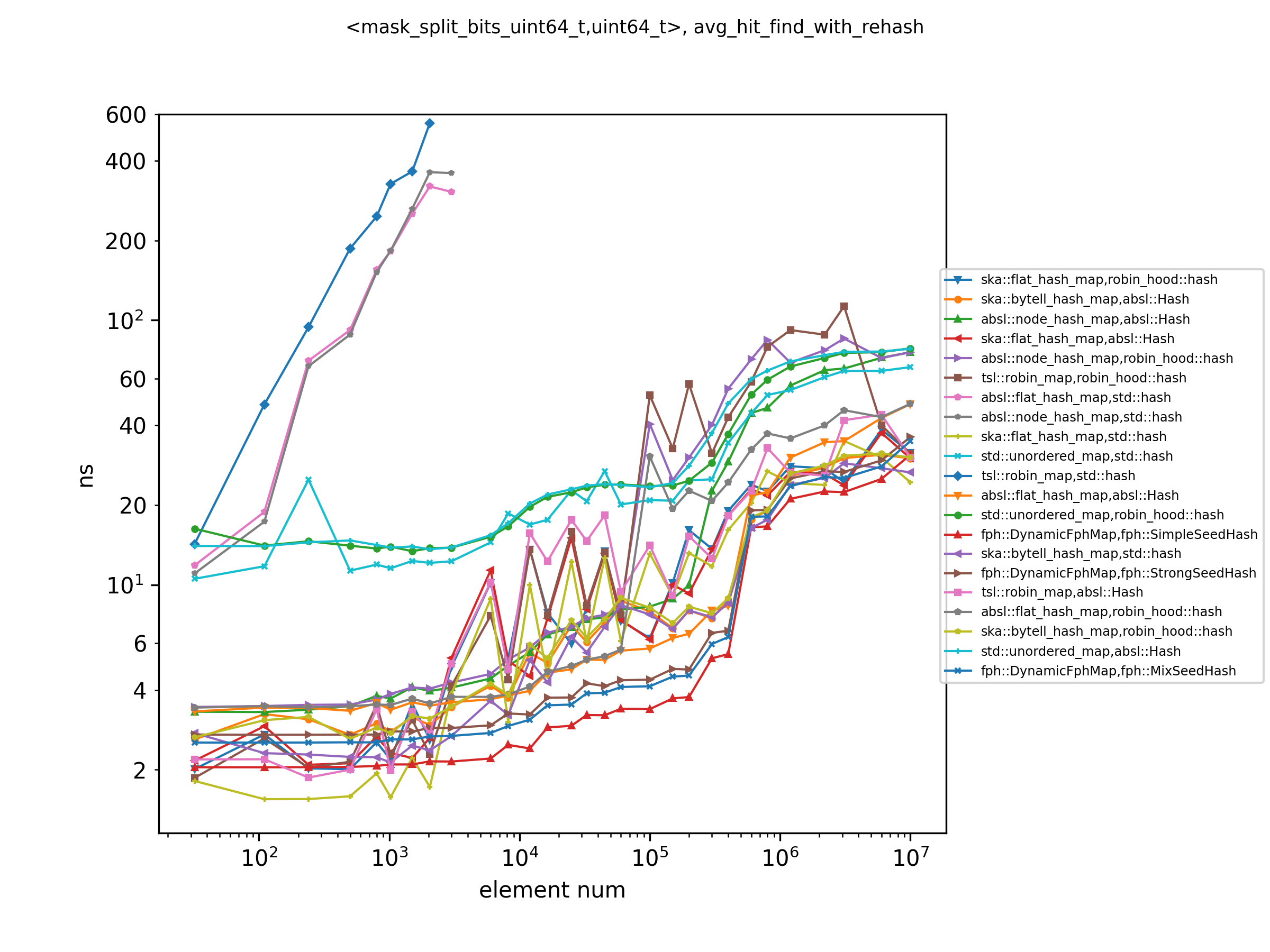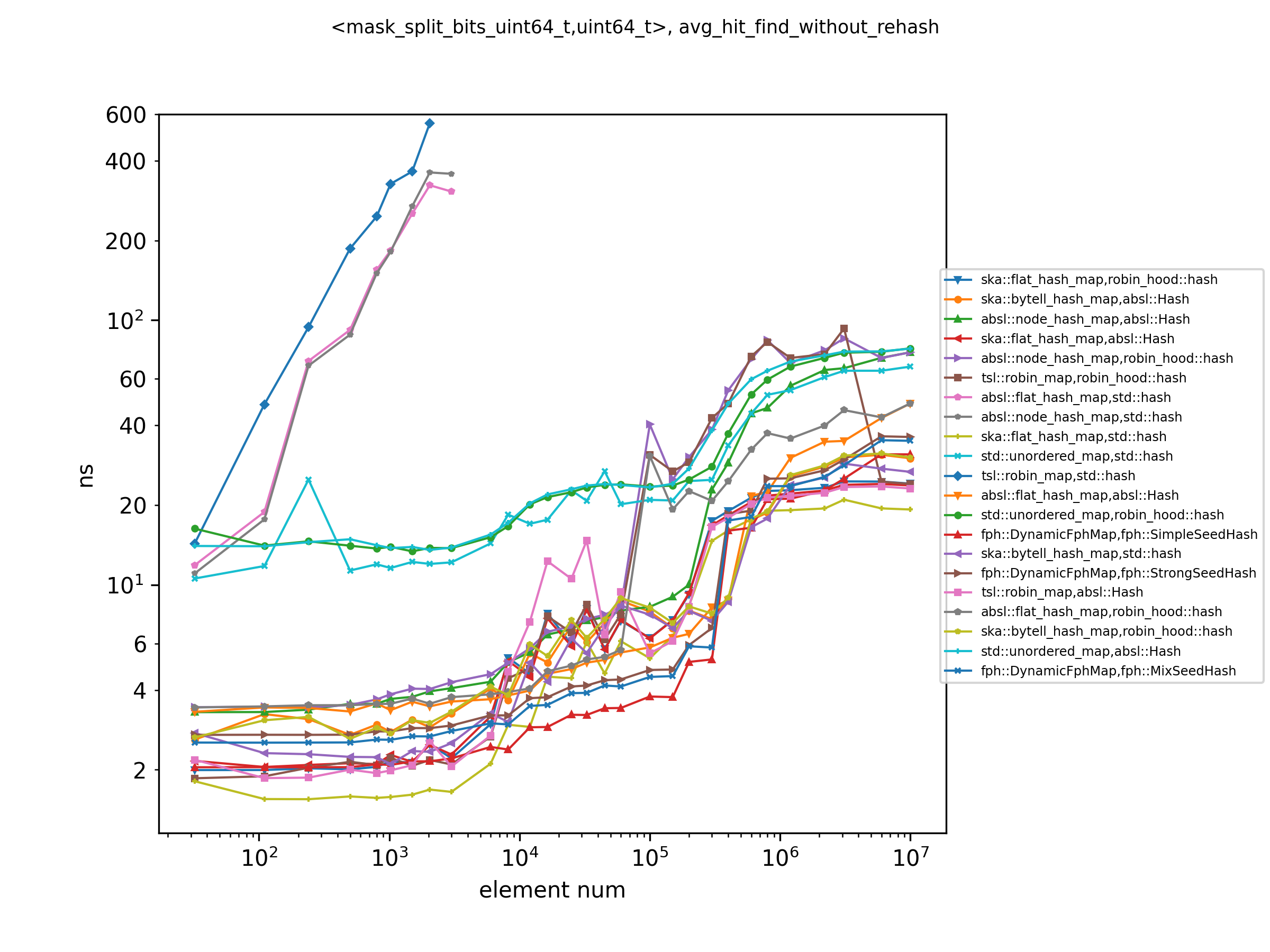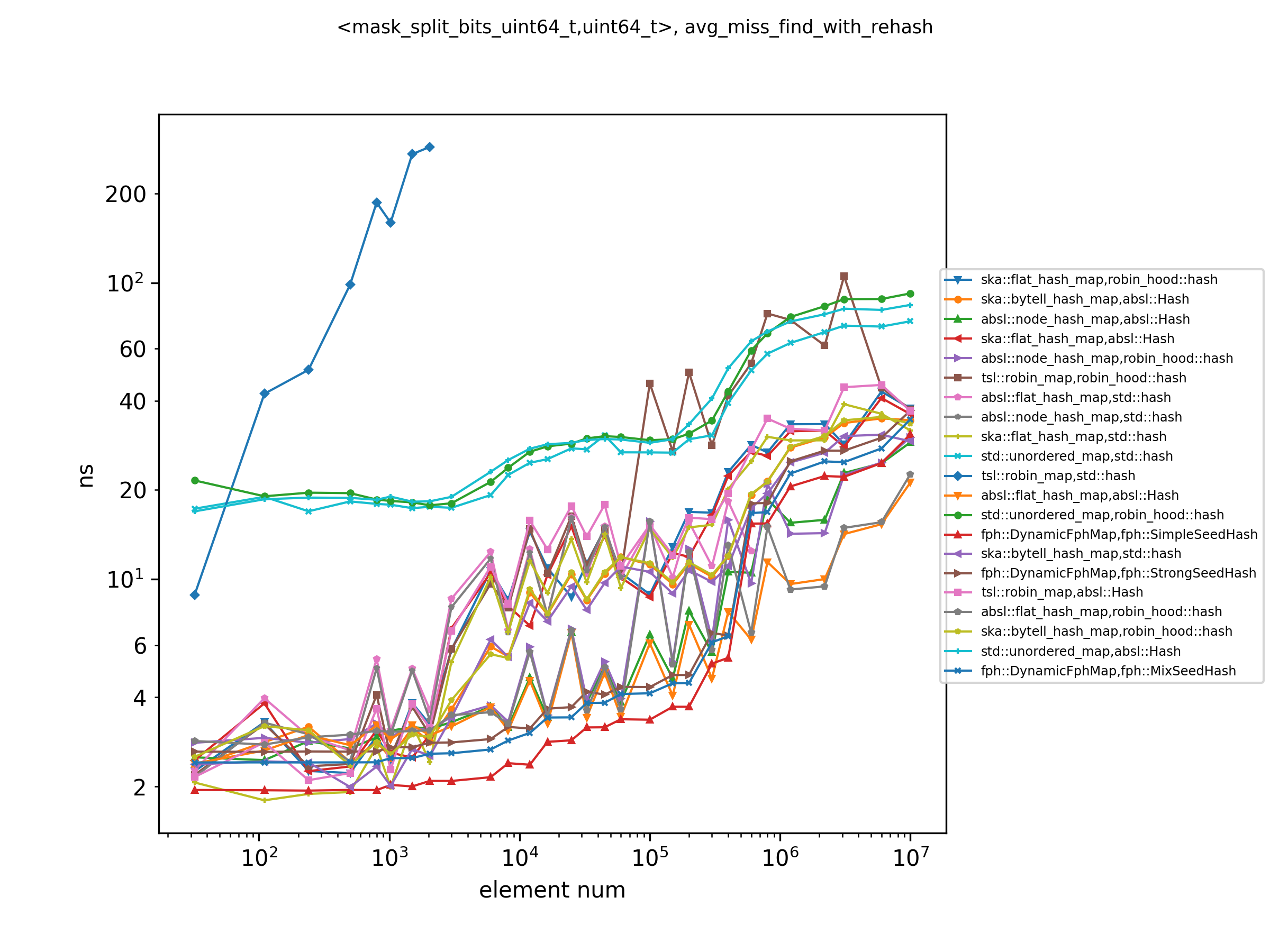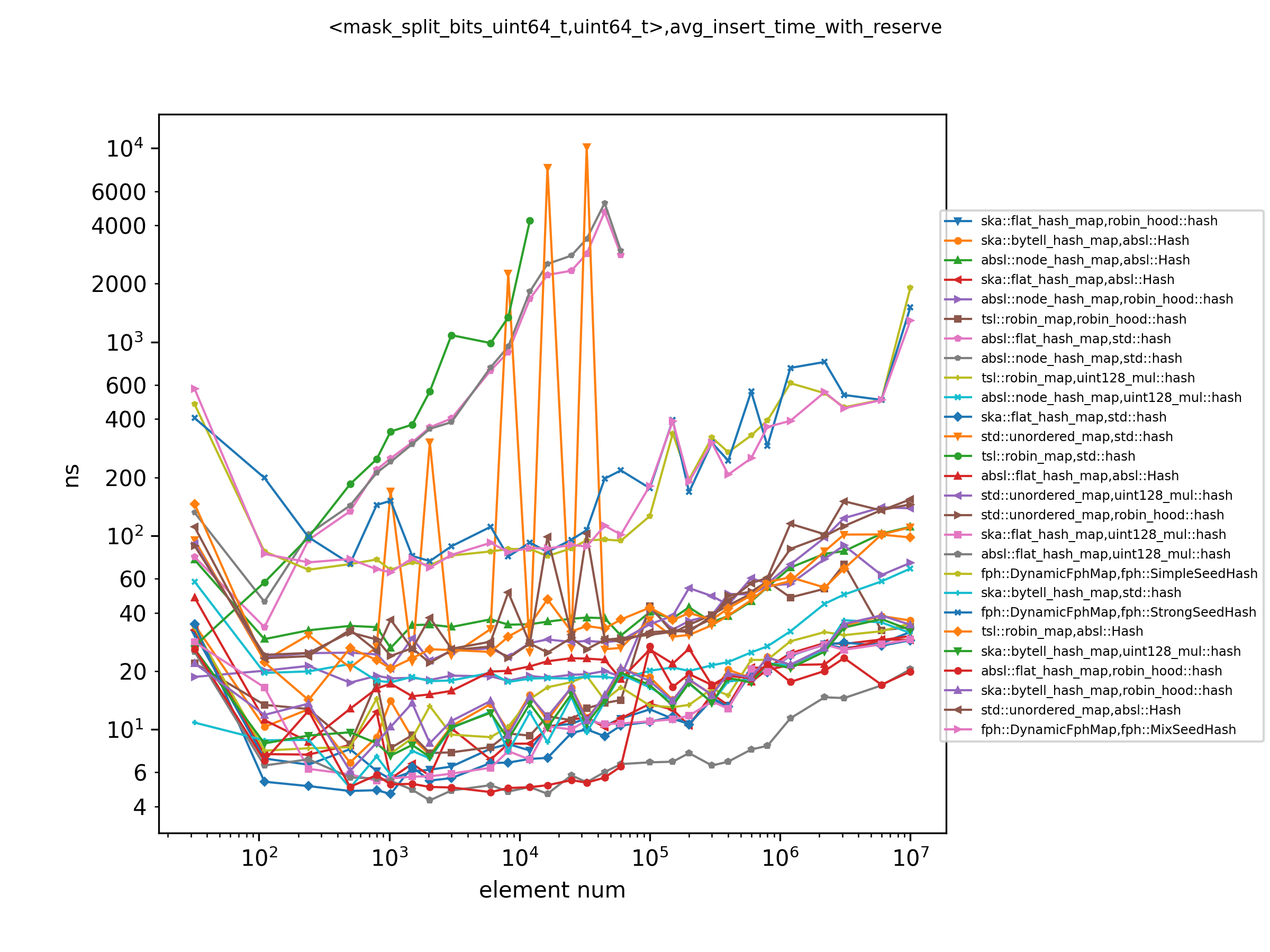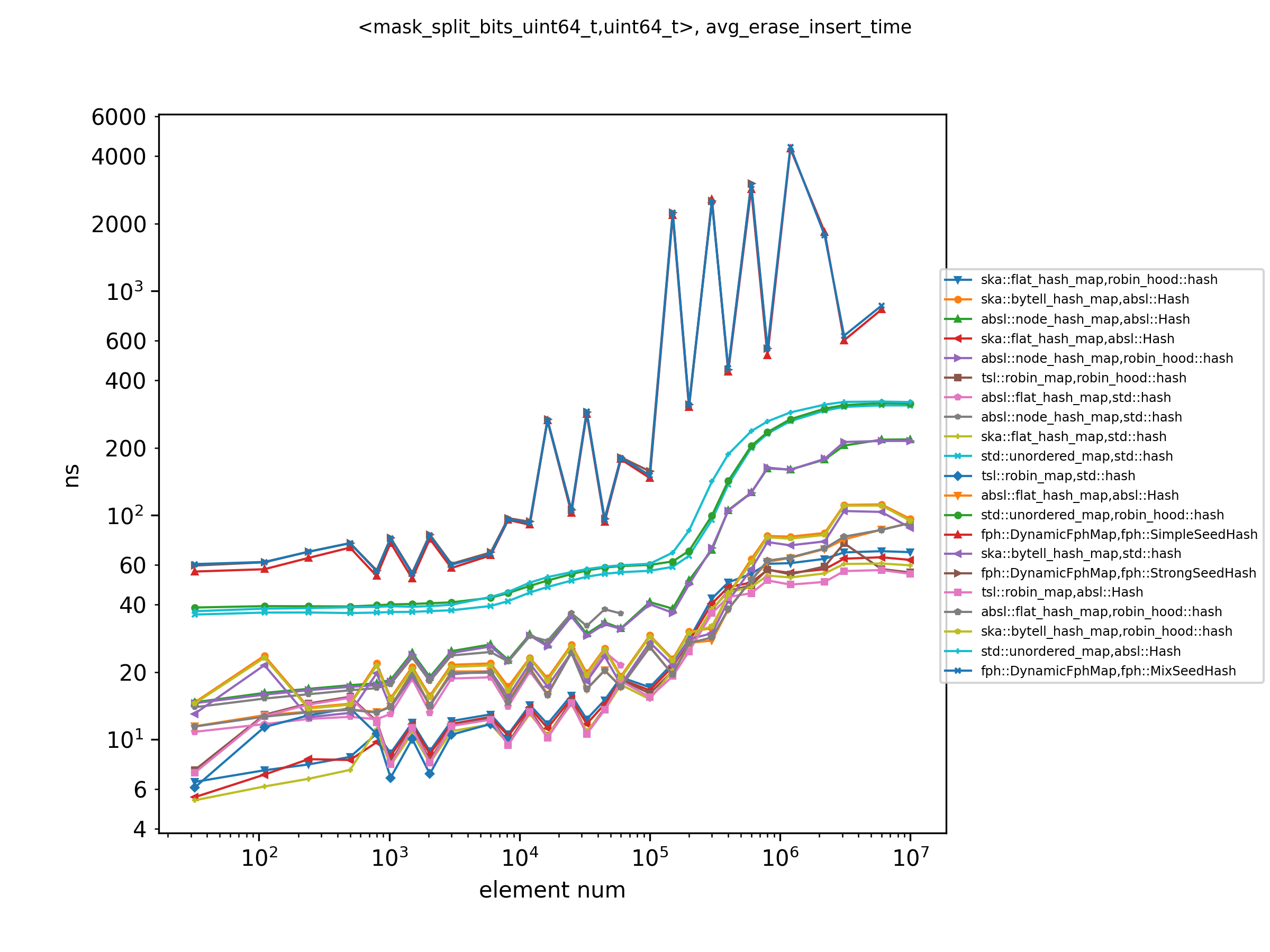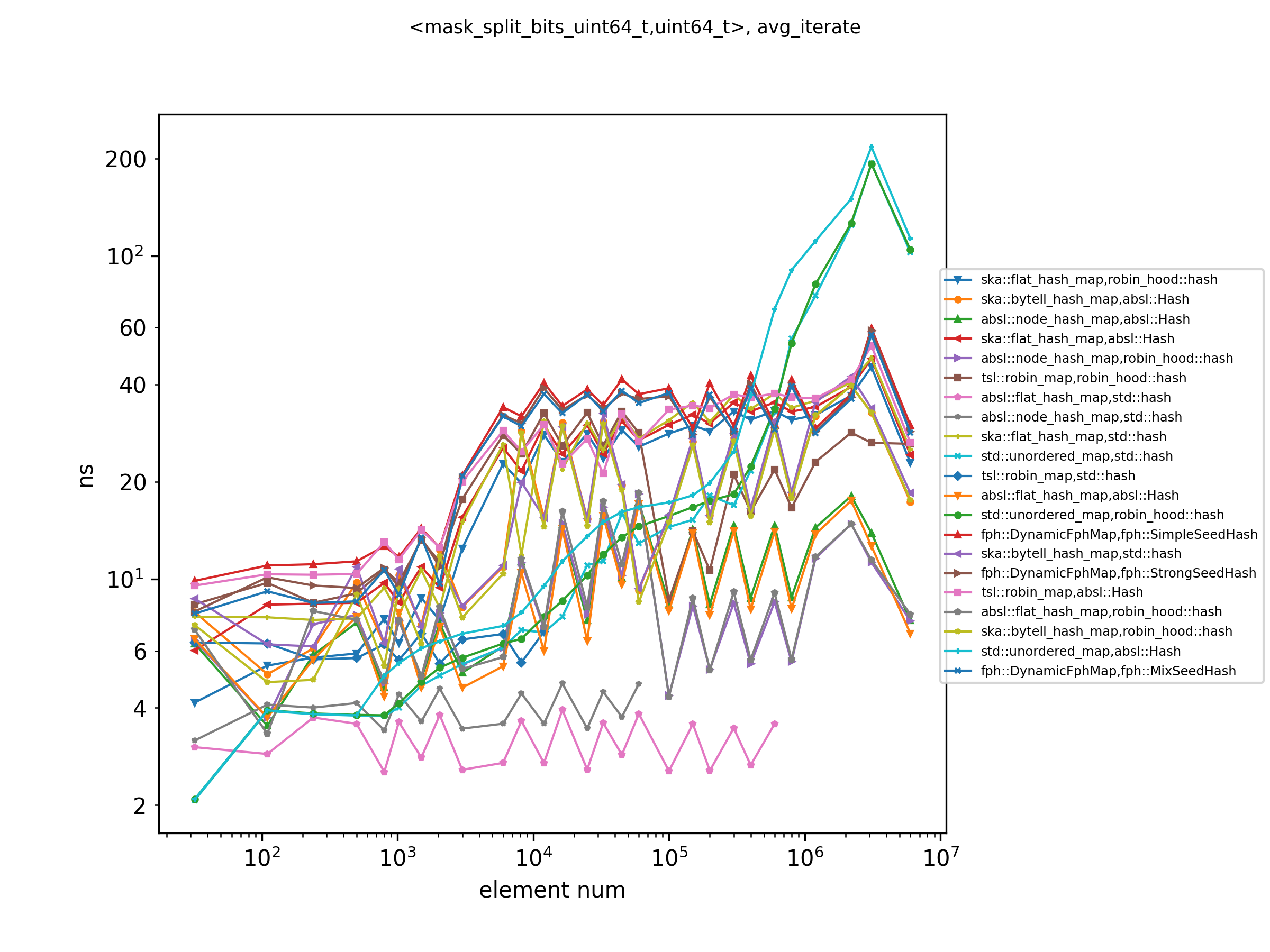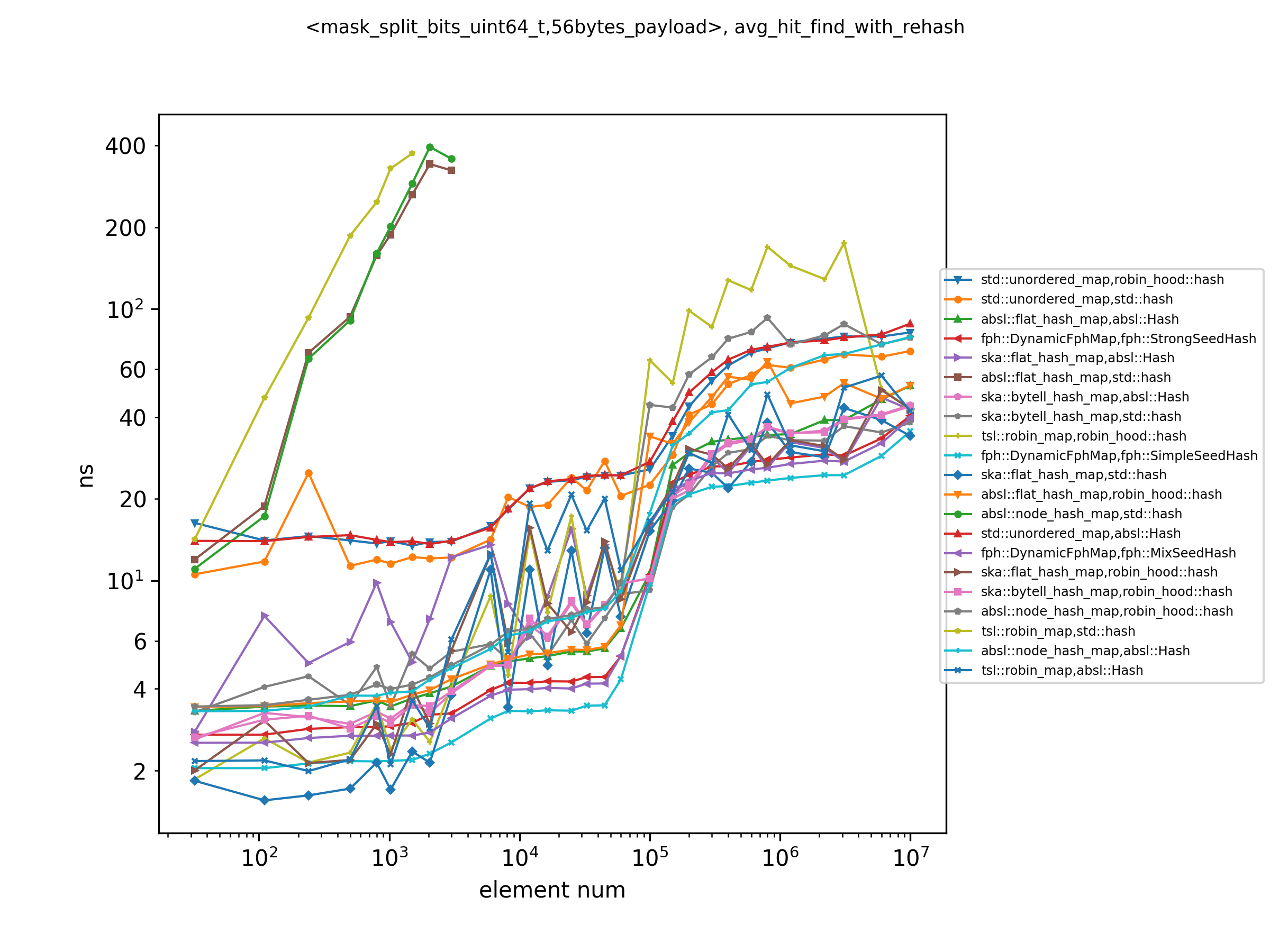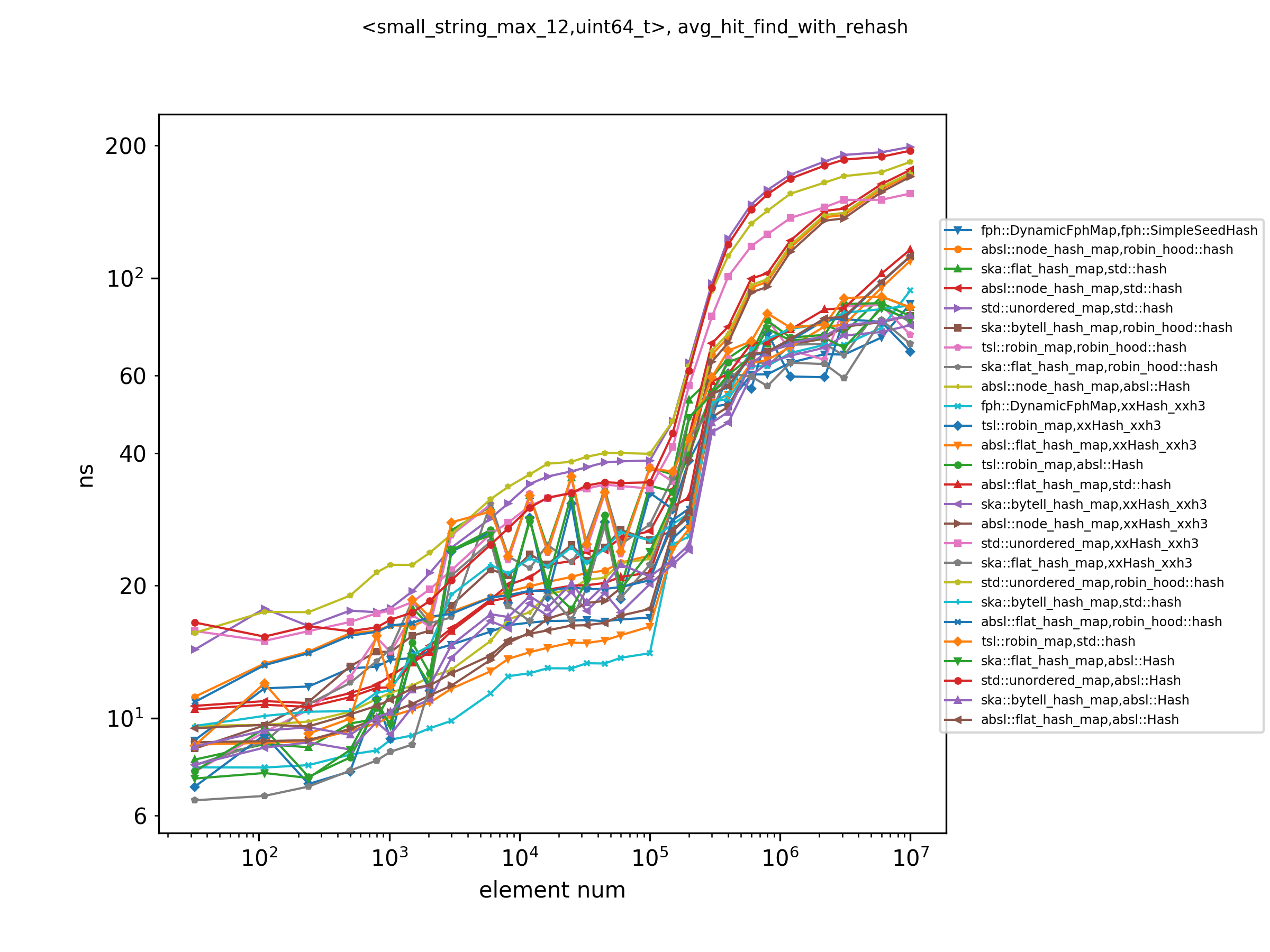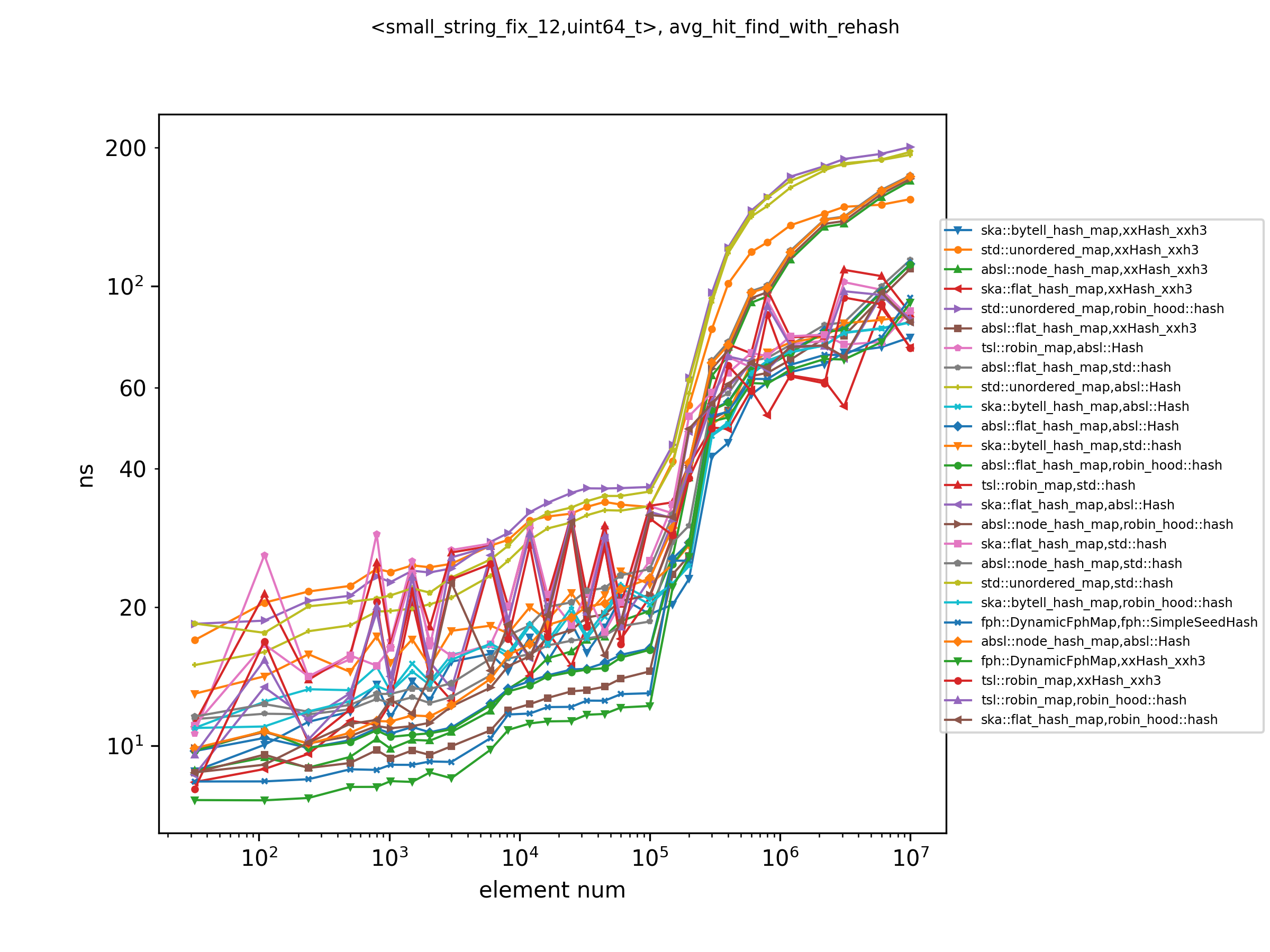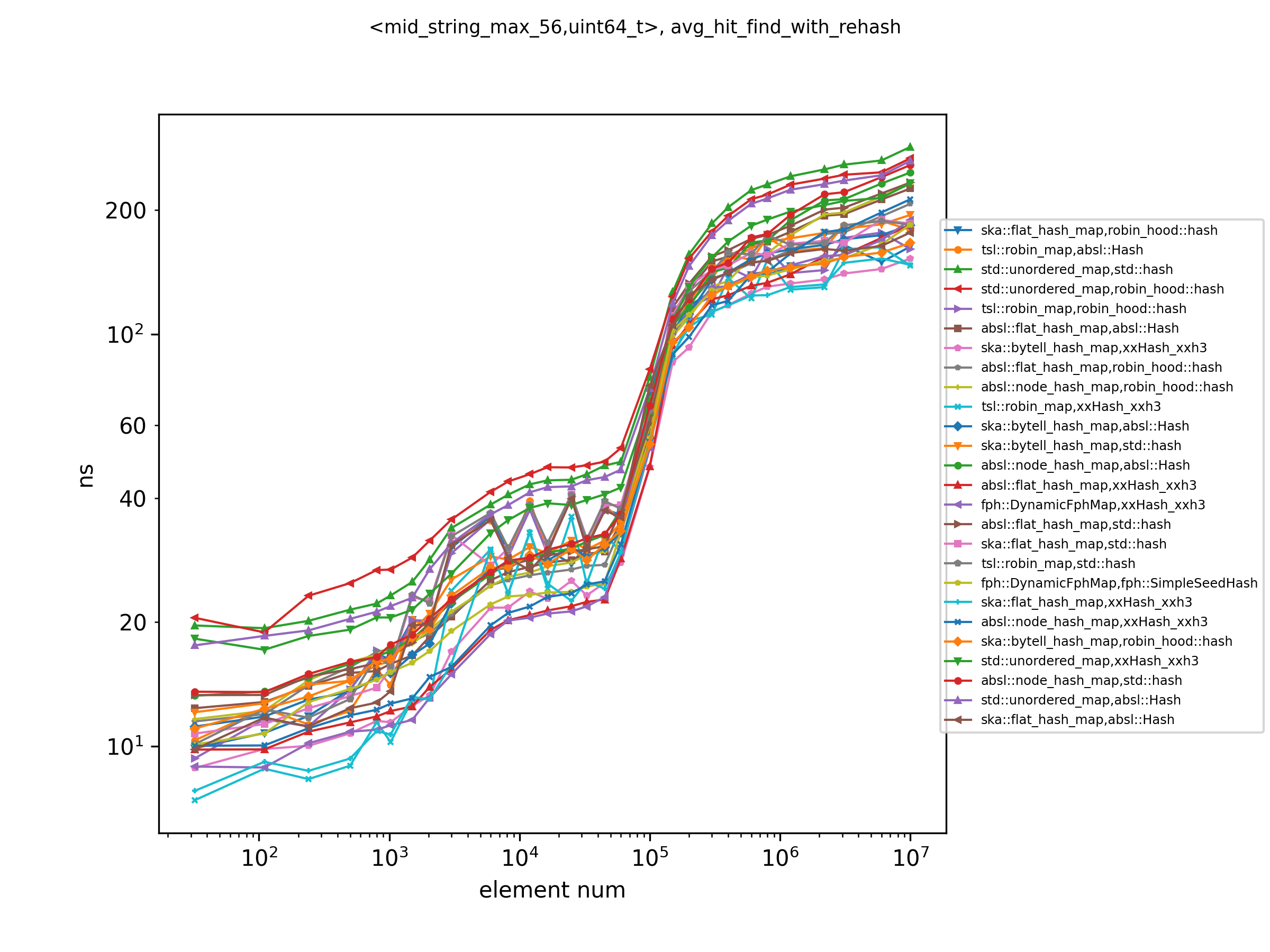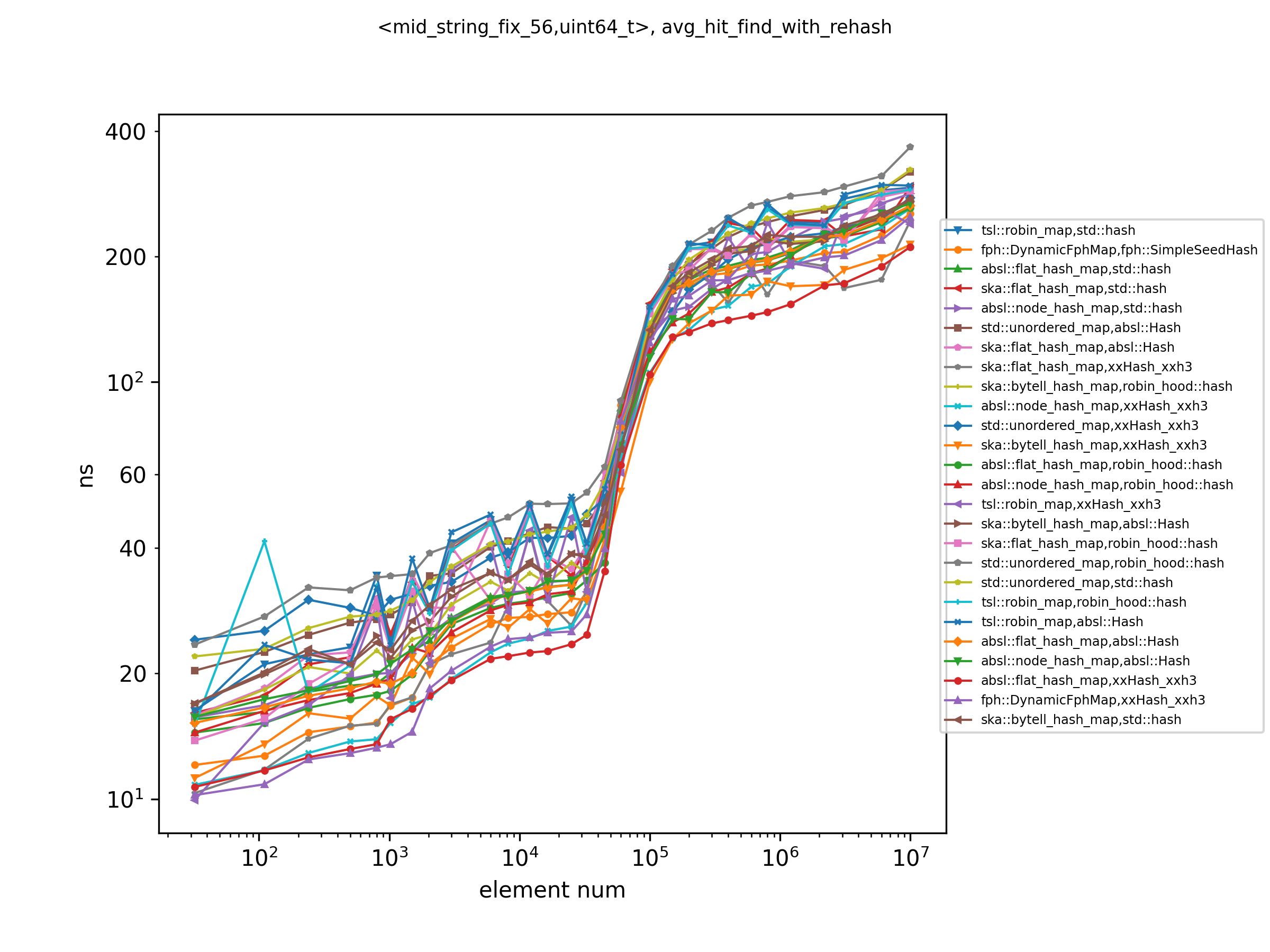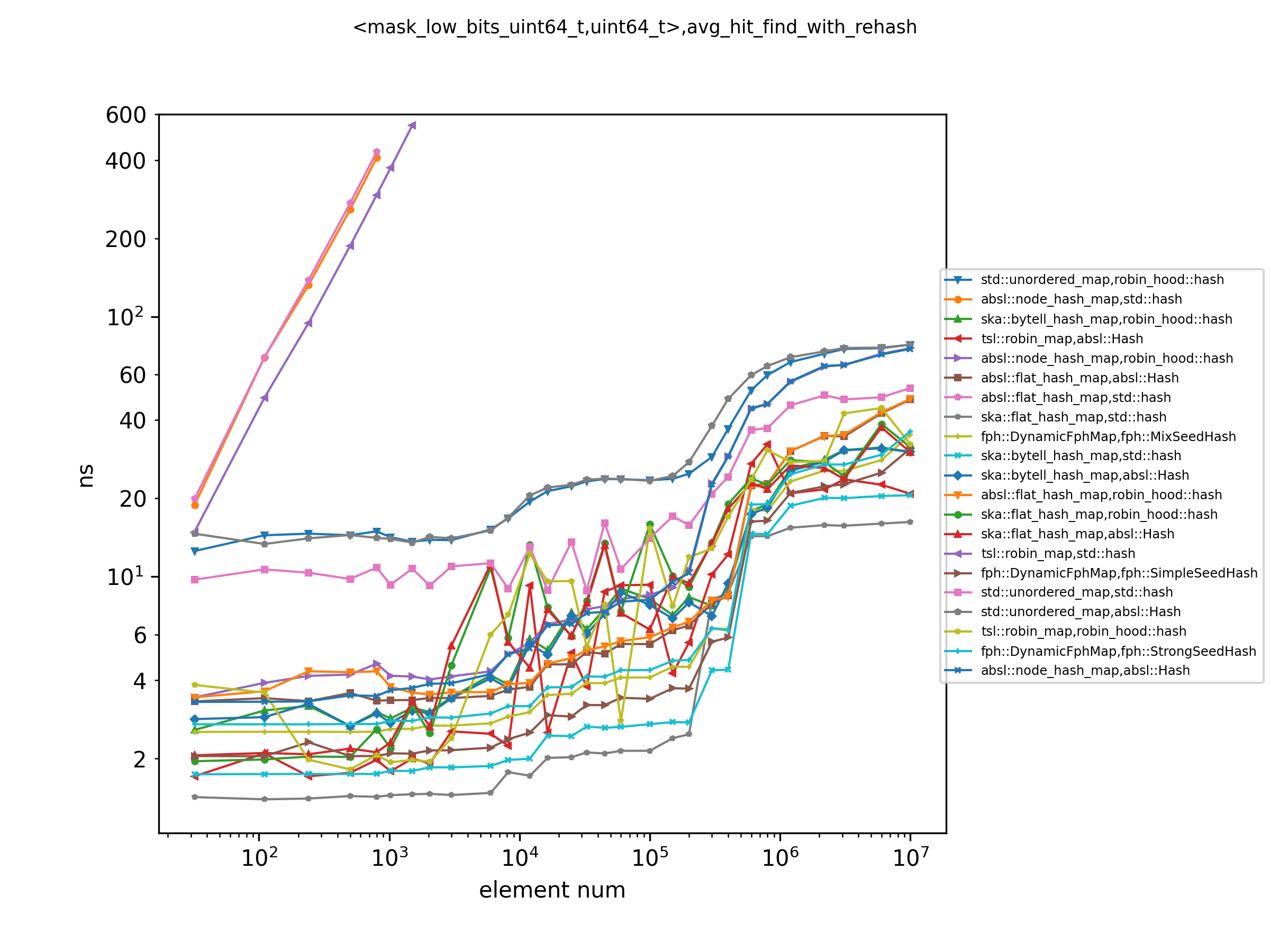This is yet another benchmark for hash tables(hash maps) with different hash functions in C++, attempting to evaluate the performance of the lookup, insertion, deletion, iteration, etc. on different data as comprehensively as possible.
If one is familiar enough with the world of hash tables, he/she will know that even for a well-known and widely used hash table, there is a data distribution that it's not very good at. In other words, no hash table is the fastest on all datasets for all operations.
The best practice for selecting a hash table needs to consider the characteristics of the data and the proportion of operations, fit the actual needs and cooperate with the most suitable hash function.
This benchmark tries to use a concise and effective method to test the performance of different operations of the hash table on some of the most common data distributions. But in fact, there must be a data distribution that is very different from the data we use for testing, and different users have different requirements for different indicators. Therefore, the best test method is to test in real applications.
We measure the combination of different hash tables with different hash functions. For each combination, we measured its insert, delete, lookup (including successful and failed lookups), and iteration performance under different data. Below is a more detailed table of test items. Please note that in the following we will use "hash table" or "hash map" indiscriminately to refer to the same concept.
| Index | Test items | Notes |
|---|---|---|
| 1 | Insert with reserve | Call map.reserve(n) before insert n elements |
| 2 | Insert without reserve | Insert n elements without prior reserve |
| 3 | Erase and insert | Repeatedly do one erase after one insert, keep the map size constant |
| 4 | Look up keys in the map (hit) | Repeatedly look up the elements that are in the map |
| 5 | Look up keys that are not in the map (miss) | Repeatedly look up the elements that are not in the map |
| 6 | Look up keys with 50% probability in the map | Repeatedly look up the elements that have a 50% probability in the map |
| 7 | Look up keys in the map with large max_load_factor (hit) | Same as Test Item 4 except that the map is set a max_load_factor of 0.9 and rehashed before the lookup operations |
| 8 | Look up keys that are not in the map with large max_load_factor (miss) | Same as Test Item 5 except that the map is set a max_load_factor of 0.9 and rehashed before the lookup operations |
| 9 | Look up keys with 50% probability in the map with large max_load_factor | Same as Test Item 6 except that the map is set a max_load_factor of 0.9 and rehashed before the lookup operations |
| 10 | Iterate the table | Iterate the whole table several times |
| 11 | Heap memory size and load factor with default and large max_load_factor | Record the heap memory size and load factor when construct the map in Test Item 4, 7 |
As you may have noticed, several of the test items are set to test the query speed of hash tables with a larger upper limit on the load factor (the load factor is an important data indicator to measure how full the hash table is, max_load_factor is an API for maximum load factor in STL). This is because each hash table may have a different expansion strategy and max_load_factor, so even with the same number of elements, they will choose different load factors, which will cause them to occupy different memory space. The load factor and size of the memory space occupied greatly affects the lookup performance, so using a hash table with a smaller max_load_factor may have worse (or better) performance when looking up. On the other hand, a higher load factor may lead to a higher probability of collision, thus reducing the lookup performance.
In addition, if a user wants extreme lookup time, he/she probably needs to make the space used by the hash table as small as possible to reduce the cache miss rate. Or, when the available size of memory is very limited, a larger load factor may be preferred. Then one of the things that can be done is to set a higher max_load_factor, and then rehash (or set a large max_load_factor before the main construction process of the table).
For each of the tests above, we tested the throughput and latency (when the platform under test meets the conditions for the latency test). The throughput results will be more representative, because modern software runs on CPUs with pipelined architectures. And almost all operations will have other instructions before and after them, which can make full use of the pipeline. However, for some specific uses, latency data is important. The latency measurement results here are for reference only for special needs and have relatively large limitations.
All the data used in the benchmark are randomly generated, the user can choose different seeds for the test data. We tested the performance of each hash table at different sizes from 32 to 10^7.
The tested keys consist of 64-bit integers of different distributions and strings of different lengths. The detailed test data is shown in the table below.
| Index | Key Type | Value Type | Notes |
|---|---|---|---|
| 1 | uint64_t with several split bits masked | uint64_t | The keys have such characteristics: only bits in some positions may be 1, and all other bits are 0. For test data of size n, at most ceil[log2(n)] fixed bits may be 1. e.g. If the key type is uint8_t (it is uint64_t in reality) and the test size is 7, the keys will be generated with the method rng() & 0b10010001. The distribution characteristics of such bits can relatively comprehensively examine whether hash tables and hash functions can handle keys that only have effective information in specific bit positions. |
| 2 | uint64_t, uniformly distributed in [0, UINT64_MAX] | uint64_t | The keys follow a uniform distribution in the range [0, UINT64_MAX]. |
| 3 | uint64_t, bits in high position are masked out | uint64_t | The bits in the high position are set to 0. For test data of size n, at most ceil[log2(n)] fixed bits may be 1. For example, if the key type is uint8_t (uint64_t in reality) and the test size is 7, the keys will be generated with the method rng() & 0b00000111 |
| 4 | uint64_t, bits in low position are masked out | uint64_t | The bits in the low position are set to 0. For test data of size n, at most ceil[log2(n)] fixed bits may be 1. For example, if the key type is uint8_t (uint64_t in reality) and the test size is 7, the keys will be generated with the method rng() & 0b11100000 |
| 5 | uint64_t with several bits masked | 56 bytes struct | The keys are the same as the distribution of the data 1. The payload is a 56 bytes long struct, which makes the sizeof(std::pair<key, value>)==64 |
| 6 | Small string with a max length of 12 | uint64_t | The key type is a string with a maximum length of 12. Both length and characters are randomly generated. The Small String Optimization(SSO) technique may be taken by the compiler. |
| 7 | Small string with a fixed length of 12 | uint64_t | The key type is a string with a fixed length of 12. The characters are randomly generated. The Small String Optimization(SSO) technique may be taken by the compiler. |
| 8 | Mid string with a max length of 24 | uint64_t | The key type is a string with a maximum length of 24. Both length and characters are randomly generated. |
| 9 | Mid string with a fixed length of 24 | uint64_t | The key type is a string with a fixed length of 24. The characters are randomly generated. |
| 10 | Large string with a max length of 64 | uint64_t | The key type is a string with a maximum length of 64. Both length and characters are randomly generated. |
| 11 | Large string with a fixed length of 64 | uint64_t | The key type is a string with a fixed length of 64. The characters are randomly generated. |
Different distributions within the range representable by uint64_t are chosen as keys. Uniformly distributed integers in the range of uint64_t are the easiest to generate with pseudo-random numbers, but it is rare in real situations.
If users are concerned with performance using integer keys, we strongly recommend focusing on the results on the first dataset rather than the second dataset (i.e. the dataset with a uniform random distribution). Because the data from the first dataset better can examine the ability of hash tables and hash functions to deal with more diverse patterns, while the test on uniform random distribution barely verifies the ability of hash tables to handle other distributions. Moreover, in terms of the data distributions that exist today, few keys happen to be uniformly randomly distributed over the [0, 2^63 - 1] range.
For the string datasets, different character sets are used. For the fixed length string, the pattern is like the first dataset, where several split bits are masked. In other words, only the bits on in some positions may diff among the these datasets. This pattern is aimed to test the quality of the hash function.
For the strings with variable length, a subset of the printable characters can appear in the string.
Real data distributions are often biased. And if a combination of hash function and hash table can only handle one distribution and cannot handle other distributions, this combination is not robust to unknown distributions. If the distribution of the data is known in advance, the user can pick the fastest and most stable hash table for that data.
Below is the hash function list we tested
| Name | Type | Notes | Link |
|---|---|---|---|
| std::hash | Normal | Implemented by compiler; identity hash is used for integer type in libc++ and libstdc++ | |
| absl::hash | Normal | Implemented by google; Use 128-bit product of multiplication and a xor-shift. | https://github.com/abseil/abseil-cpp |
| robin_hood::hash | Normal | For integer keys, it use xor-shift, multiplication, xor-shift; For string keys it is similar to MurmurHash | https://github.com/martinus/robin-hood-hashing |
| xxHash_xxh3 | Bytes | Designed for string; We use identity hash for integer type to pass compilation; Results on integer keys will not be displayed. | https://github.com/Cyan4973/xxHash |
Originally we have some seed hash functions in the tests, which are hash functions that take both a key and a seed as the arguments. We remove these hash functions to keep the test subjects simple, and we use the no-seed version of all the hash tables.
We will not show the results of hash xxHash_xxh3 in tests on integer keys.
For the early versions of absl::Hash, the behavior on arm64 platform is
different from that on x86-64 platform, and it was poor for some datasets. So
we once had a uint128_mul::hash to compare with it, which is similar to the
absl::Hash on x86-64 platform. Since the newest version of absl::Hash has
fixed this problem. We deleted the uint128_mul::hash.
The following table lists the hash tables we tested, some of these hash tables rely on a "good" hash function to work properly, which can generate hash values that are as uniformly distributed as possible for unbalanced keys. If a hash function that does not have such property (e.g. identity hash) is used, then the performance of these hash tables may drop drastically. These hash tables may have the assumption that the hash values of the keys from the dataset are uniformly distributed in the output range. This requires the hash functions to have the properties like uniformity or diffusion.
The implication here is that a "good" hash function tends to be more complex than the simplest hash function (the identity hash), requiring more instructions to complete the computation. Some hash tables do not rely on a good hash function, may due to that they have done some extra work to ensure the uniformity of the hash values. For such a hash table, the simpler the hash function, the better, preferably the identity hash. So we should always compare the combinations of hash tables and hash functions, rather than fixing the hash function to compare the hash table, or vice versa.
Here are the hash maps we tested.
| Name | Require good hash function | Notes | Link |
|---|---|---|---|
| std::unordered_map | No* | Implemented by the stl library; May differ in libc++ and libstdc++. | |
| ska::flat_hash_map | No | Very fast and simple; Use robin hood hash; Memory overhead: alignof(value_type) per element; Require small load factor | https://github.com/skarupke/flat_hash_map |
| ska::bytell_hash_map | No | A little slower than ska::flat_hash_map but one byte per element memory overhead | https://github.com/skarupke/flat_hash_map |
| absl::flat_hash_map | Yes | Use SIMD and metadata; Fast when looking up keys that are not in the map; One byte per element memory overhead | https://abseil.io/about/design/swisstables |
| absl::node_hash_map | Yes | Slower than absl::flat_hash_map but does not invalidate the pointer after rehash | https://github.com/abseil/abseil-cpp |
| tsl::robin_map | Yes | A fast hash table using robin hood hash; Memory overhead is no less than ska::flat_hash_map | https://github.com/Tessil/robin-map |
| emhash::HashMap7 | Yes | Fast in lookup hit operations. | https://github.com/ktprime/emhash |
| fph::DynamicFphMap | No | A dynamic perfect hash table; Ultra-fast in lookup but slow in insert; 2~8 bits per element memory overhead | https://github.com/renzibei/fph-table |
| fph::MetaFphMap | No | A dynamic perfect hash table using metadata; Better than fph::DynamicFphMap in the miss lookup case. | https://github.com/renzibei/fph-table |
| robin_hood:unordered_flat_map | Yes | A table using robin hood hash; |
* Note: For the tested libc++ and libstdc++ version, the libc++ implementation requires a good hash function but no such requirement for libstdc++.
With a quick glance you can easily find that many hash tables listed use the robin hood hashing technique in the pursuit of speed.
OS: Linux, macOS, or Windows
Compiler: Only GCC and Clang have been tested; You may test with MSVC and contribute to the benchmark. The compiler has to support C++17 or newer standard.
Build Tool: CMake >= 3.10
First, clone this repo to the machine, then update the submodules
cd hashtable-bench
git submodule update --init --recursiveUse CMake to make the targets
mkdir build
cd build
cmake .. -DCMAKE_BUILD_TYPE=Release # (default option: -DBENCH_ONLY_INT=OFF -DBENCH_ONLY_STRING=OFF)
make -j8Use the python script provided to run all the tests in the benchmark. If you are using linux, you may change the core affinity settings in it (which is at the beginning of that script) or use the external taskset command to set the core affinity of the python process.
cd ../tools
python3 run_bench.py seed export_results_directory_pathThe results of the tests will be in the format of csv files. You can use the jupyter notebook
tools/analyze_results.ipynb to parse and generate plots of the results.
- One can easily add new hash functions and hash maps.
- Data with different distributions, different characteristics, and different types are tested.
- Tested as many operations on hash tables as possible.
- Provides a convenient tool for visualizing test results.
- Support the hash tables with a seed hash function (which takes both a key and a seed as the function arguments) like Flash Perfect Hash.
One can follow the samples in src/hashes/std_hash and src/maps/std_unordered_map. If the new hash function or the
hash map has a repo in the GitHub, you can add it as a submodule (put in thirdparty/) and then use CMake addsubmodule
or just add the include directories.
After the new hash directory or hash map directory is added, run the CMake command to generate the build targets.
In our tests, almost all computer resources can be monopolized by the test program, especially cache resources. And this is relatively rare in practical applications. In fact, other processes and tasks may occupy part of the cache. In practical applications users should expect a lower available cache size.
We neither did a warmup, nor did we specifically test the cold start scenario. In our tests, we repeatedly test an operation with a range of data many times. Therefore, when the number of operations is much greater than the amount of data, it can be considered that most operations are accessing the warm cache. When the number of operations is less than the number of data, most operations are accessing cold memory. In our test, limited by the test time, when the amount of data is small, the number of operations will be much greater than the amount of data; and when the amount of data is large, the number of operations will be equal to the amount of data.
The size of the test space contains at least
|hash table set| x |hash function set| x |data sets| x |operation set| x |hardware platform set| x |compiler set|
As you can see, the testable space is quite huge. Any addition to the set of hash tables or the set of hash functions will greatly increase the testing effort. Due to time and resource constraints, we have only explored some of the combinations, and there are still many combinations and spaces that we have not tested.
Here we show part of the test results. For complete test results, users can visualize the csv data using the tools we provide.
For throughput data, performance will be represented by the average time per operation. We will plot the average time per operation for different scales of data. The shorter the time, the better the performance.
If too much time is spent in a test, we will count it as the timeout and set the time as zero, and that data point won't be plotted.
Platform 1: Intel(R) Xeon(R) E-2286G CPU @ 4.00GHz, boost to 4.6 GHz; 32 GB 2666 MHz dual channel DDR4 RAM; Ubuntu 20.04; gcc 9.4.0; x86-64; Coffee Lake;
Platform 2: M1 Max Macbook Pro 16 inch, 2021; 64 GB quad channel LPDDR5 RAM; macOS 12.1; clang 13.1.6; arm64; Firestorm;
Due to the lack of high-precision time stamp counters available on other platforms, we only measured the latency on the x86-64 platform. In addition, for the x86-64 platform, we have also taken some measures to ensure the stability of the measurement results, including the following:
- Use the
tasksetcommand to set cpu core affinity - Turn off hyperthreading
- Isolate the cores by add
isolcpus=andrcu_nocbs=inGRUB_CMDLINE_LINUXin/etc/default/grub - Turn off some powersaving option, including disable
ondemandsystemd service, setidle=pollandintel_idle.max_cstate=0in grub cmd line. - Turn off timer tick interrupts, recompile the kernel with
CONFIG_NO_HZ_FULL=yand setnohz_full=in grub cmd line. - Other adjustments that de-jitter the system latency. You can refer to https://rigtorp.se/low-latency-guide/.
These measures cannot be done on macOS. But as we do not measure the latency of operation on macOS, it doesn't matter that much.
Figure 1: Look up keys in the map with 0.9 max_load_factor, tested in AMD 3990x Figure 2: Look up keys in the map with 0.9 max_load_factor, tested in Apple M1 Max Figure 3: Look up keys in the map with default max_load_factor, tested in AMD 3990x Figure 4: Look up keys in the map with default max_load_factor, tested in Apple M1 Max Figure 5: Look up keys that are not in the map with 0.9 max_load_factor, tested in AMD 3990x Figure 6: Look up keys that are not in the map with 0.9 max_load_factor, tested in Apple M1 MaxThe first thing we need to be clear about is that the lookup performance of the hash table is directly related to the cache hit rate. So one can see clearly from figure 1 that in x86-64 architecture, the performance of the query is roughly divided into four levels by the number of elements:
- Elements can be fully loaded into the L1 cache; When sizeof(value_type) is 16 bytes and the L1 data cache is 32 KB, there can be about 2048 elements at most
- Elements can be fully loaded into the L2 cache; When sizeof(value_type) is 16 bytes and the L2 cache is 512 KB, there can be about 32768 elements at most
- Elements can be fully loaded into the L3 cache; When sizeof(value_type) is 16 bytes and the L2 cache is 16 MB, there can be about 10^6 elements at most
- A lot of reads from RAM are bound to occur; When L3 cache can not fully contain the elements, here is roughly when there are more than 10^6 elements
In addition to the cache miss, TLB miss is also a major factor affecting the lookup speed of hash tables. Zen2 has 64 L1 TLB entries and 2048 L2 TLB entries. This means if a 4KB page size is used, there will be a lot of L1 TLB miss when the number of elements is larger than 16384 and L2 TLB miss when the number is larger than 524288. If huge pages are used, there can be far less TLB miss. On macOS using m1 max, a 16 KB page size is used by default. So the penalty caused by TLB miss is much smaller than the default setting of the zen2 platform.
When the task is to find an element in a hash table, from figure 1 and figure 2, we can see that in x86-64
(more specifically, tested in zen2) architecture, with a large max_load_factor, when the size of elements is smaller
than 1000, ska::flat_hash_map with std::hash is the fastest combination of hash tables. When the number of elements
exceeds 1000, fph::DynamicFphMap with fph::SimpleSeedHash is the fastest in lookup.
In arm64 (tested in Apple Silicon) architecture, fph::DynamicFphMap with fph::SimpleSeedHash has the fastest
lookup speed regardless of the number of elements. ska::flat_hash_map with std::hash are also very competitive with
less than 2000 elements.
In addition, we can find that for those hash tables that require the quality of the hash function, the lookup performance
on this data distribution is poor when using std::hash. By contrast, for those hash tables that do not rely on good
hash functions (such as ska::flat_hash_map and fph::DynamicFphMap), simpler hash functions (such as std::hash and
fph::SimpleSeedHash) can make their lookup operations faster because less time is spent on hash functions.
According to our observations, the current implementation of absl::hash on the arm64 architecture is not quite good as
it cannot make good use of the information of the higher bits of the integer key value (which is more obvious on the
datasets where the lower bits of keys are masked out.). uint128_mul::hash, which does not use the fallback method, is
very fast on the arm64 platform.
Comparing figure 1 and figure 3, we can also see that some hash tables with a larger load factor have better lookup performance, such as DynamicFphMap, because of less memory usage and low cache miss rate. Some hash tables, such as ska::flat_hash_map and tsl::robin_map, perform worse for a larger load factor, possibly because the collision rate becomes higher.
Observing Figure 5 and Figure 6, it can be concluded that for looking up elements that are not in the hash table, when
the number of elements is not very large (more specifically, all elements can fit in the L3 cache), the
fph::DynamicFphMap has the fastest lookup speed; and when the number of elements becomes larger,
absl::flat_hash_map has the fastest lookup speed. absl::flat_hash_map can have such high query performance in this
scenario is understandable, because it uses a metadata table of 1-byte per element and SIMD instructions, which means
that it can determine whether the key to be looked up is contained in a dozen possible positions. The 1 byte metadata
per element needs much smaller space to store than the complete element array, so the cache hit rate is much higher than
other hash tables.
From Figure 7 and Figure 8, it can be found that hash ska::flat_hash_map with std::hash has excellent performance
when the number of elements is small. When the number of elements becomes too large to fit in the L2 cache,
absl::flat_hash_map has the highest performance with a suitable hash function (such as hash absl::hash in x86-64
or uint128_mul::hash).
It should be noted that the results of this test are also highly correlated with the distribution of the data. Especially the relationship between deleted data and inserted data. Here we are randomly selecting elements to delete with equal probability. In reality, the way of selecting elements may not be equal probability, for example, the most likely deleted element is the most recently inserted element.
In this test, ska::flat_hash_map has almost the best erase and insert performance regardless of the number of
elements. tsl::robin_map performs almost as well with more than 1000 elements.
Although the combination of absl::flat_hash_map and absl::node_hash_map with std::hash iterate very fast when
the amount of data is small, it can be seen that they have no test results when the amount of data is large. This is
because these combinations insert elements so slowly that they time out. So they shouldn't be included in the statistics
of the fastest iterating hash table.
When the amount of data is small, the iteration speed of std::unordered_map is unexpectedly fast. And when the amount
of data begins to increase, absl::flat_hash_map and absl::node_hash_map become the fastest iterative hash maps.
Due to space limitations, comprehensive results are not presented in this document.
Figure 13: Look up keys in the map with 0.9 max_load_factor, tested in AMD 3990x Figure 14: Look up keys in the map with 0.9 max_load_factor, tested in Apple M1 MaxWe can see that the relative performance of the hash tables is similar when using uint64_t as the payload.
On x86-64 platform, ska::flat_hash_map is still excellent when the number of elements is small, and the lookup
performance of fph::DynamicFphMap is the best when the number of elements is large.
On the arm64 platform, fph::DynamicFphMap using fph::SimpleSeedHash has always been the fastest hash table in lookup.
Since the size of a single element becomes larger, it is easier for the cache hit rate to drop due to the increase in the number of elements.
Figure 15: Look up keys in the map with 0.9 max_load_factor, tested in AMD 3990x Figure 16: Look up keys in the map with 0.9 max_load_factor, tested in Apple M1 MaxComparing different hash functions, it can be found that on the x86-64 platform, xxHash_xxh3 is almost the fastest on
each data scale for this dataset. By contrast, robin_hood::hash is faster on the arm64 platform.
When the amount of data is very small or very large, ska::flat_hash_map is the fastest hash map for lookup. And when
the data size is medium, fph::DynamicFphMap has the best query performance.
This dataset is what we consider the least representative because there are too many random parameters for strings of indeterminate length. At least compared to fixed-length strings, the distribution characteristics of the length of a string can only be determined by specific problems. Names, English words, place names, stock codes, identity numbers, base64 encoding of md5, etc. all have different length distributions. Therefore, the difference between the datasets whose keys are strings is too great. If there is a need, users should test it against their actual data.
The lengths of the strings here are roughly uniformly distributed between approximately 1 and the maximum length. It is said to be "roughly" because it is not completely uniform. The shorter the length, the less the selection space of the string. For example, if the dictionary has only 26 letters, a string of 1 length can only hold 26 combinations. This results in more strings with longer lengths than strings with shorter lengths.
Figure 17: Look up keys in the map with 0.9 max_load_factor, tested in AMD 3990x Figure 18: Look up keys in the map with 0.9 max_load_factor, tested in Apple M1 MaxFor strings of fixed length 12, fph::DynamicFphMap is the fastest in lookup operations for almost any number of
elements on the x86-64 platform. ska::flat_hash_map and ska::bytell_hash_map also have fairly good lookup speed
when the number of elements is large. On the arm64 platform, ska::bytell_hash_map dominates test results with a very
large number of elements.
For the hash functions participating in the test, hash xxHash_xxh3 can make the hash table play the fastest lookup
performance. But does this mean that xxHash_xxh3 is the fastest for a fixed 12-byte string? It's not that simple.
In general, hash functions designed for byte arrays (strings) need to consider various odd byte lengths and various
memory alignment lengths. Therefore, these hash functions generally use unaligned fetch methods to avoid undefined
behavior. And the branches and non-trivial instructions brought about by these considerations can make the hash function
slower. If we already know that the length of the string is a fixed 12 bytes (or other bytes) and the memory is aligned
to machine word width, we can design a faster hash function.
For example, below is a hash function with seed for 12 bytes data. This is not a good hash function in the usual sense,
but it is a very fast and good enough hash function for fph::DynamicFphMap. This function assumes that the starting
address of the input data is 8-byte aligned, and the data length is fixed at 12 bytes, so no dirty special handling is
required.
inline uint64_t Hash12Bytes(const void* src, size_t seed) {
uint64_t v1 = *reinterpret_cast<const uint64_t*>(src);
uint32_t v2 = *reinterpret_cast<const uint32_t*>(((const uint64_t*)src) + 1);
v1 *= seed;
v1 ^= v2;
return v1;
}Figure 19 compares the lookup performance of this hash function and xxHash_xxh3 when used with fph::DynamicFphMap.
Figure 19 clearly shows that the specially designed hash function for 12bytes is faster than the more general hash
function xxHash_xxh3 when used with fph::DynamicFphMap at any data scale.
Therefore, if the user is looking for the ultimate performance, then when the key is a short fixed-length string, an optimized hash function should be provided for the hash table.
Figure 20: Look up keys in the map with 0.9 max_load_factor, tested in AMD 3990x Figure 21: Look up keys in the map with 0.9 max_load_factor, tested in Apple M1 MaxIt can be found from the test results that hash xxHash_xxh3 performs better on the x86-64 platform on the data
tested here, while hash robin_hood::hash is better on the arm64 platform.
When the amount of data is small or is very large, both hash ska::flat_hash_map and tsl::robin_map have the fastest
lookup speed (tsl::robin_map does not perform so well on the arm64 platform).
On the x86-64 platform, the lookup speed of fph::DynamicFphMap and absl::flat_hash_map is the fastest when the
amount of data is moderate. On the arm64 platform, fph::DynamicFphMap has very extraordinary query performance when
the amount of data is moderate and very large. ska::bytell_hash_map has a competitive performance on all scales of
data on both platforms.
Again, like the string dataset with a maximum length of 12 bytes, this random-length dataset is very unrepresentative. The length distribution of strings in different application scenarios is completely different, and more specific data sets should be tested to obtain accurate results.
Figure 22: Look up keys in the map with 0.9 max_load_factor, tested in AMD 3990x Figure 23: Look up keys in the map with 0.9 max_load_factor, tested in Apple M1 MaxFor this dataset, lookup performance again shows somewhat different results on two platforms with different instruction sets.
On x86-64 platforms, xxHash_xxh3 is the fastest hash function that works with a hash table. fph::DynamicFphMap has
the fastest lookup speed when there is little data. absl::flat_hash_map has excellent lookup performance no matter
what data size, especially when the amount of data is large.
On the arm64 platform, no hash function is the fastest with all hash tables. xxHash_xxh3 and fph::SimpleSeedHash
(which is almost the same as robin_hood::hash when key type is string) have their advantageous data sizes when paired
with different hash tables. fph::DynamicFphMap combined with xxHash_xxh3 has the fastest lookup performance on
smaller data sizes. fph::DynamicFphMap using fph::SimpleSeedHash and absl::flat_hash_map using xxHash_xxh3
have superior lookup performance on all data sizes. The combination of fph::DynamicFphMap and fph::SimpleSeedHash
is the fastest especially when the data size is large.
The keys in this test data are integers whose bits in the high positions will change while other bits remain the same. Data patterns with this characteristic sometimes occur when the developers construct 64-bit integers with keys shorter than 64 bits. And if the hash function or hash table cannot handle the high-order bit information well, it will have poor performance.
On the x86-64 platform, when std::hash is used, both ska::flat_hash_map and ska::bytell_hash_map perform quite
well. This may be because the Fibonacci hashing
used internally by these two hash tables is well suited for data of this nature.
On the arm64 platform, ska::flat_hash_map and ska::bytell_hash_map also perform extremely well. At the same time,
fph::DynamicFphMap has almost the same excellent performance. This performance should come from the fact that they hit
the right slot almost in one shot on this data distribution. At the same time, we note that for those hash tables that
rely on good hash functions, in addition to the poor performance when using std::hash, using absl::hash also brings
disastrous performance. This should be caused by the poor hashing properties of the implementation of absl::hash on
the arm64 platform. At least that's how it turns out in January 2022, when it's tested.
Reviewing our test results, we can find that the performance is different for different key types, different operation types, different data scales, different data distributions, and different machine platforms.
The results we show are only for ideal test environments on some common data distributions and common machine platforms. The reality is often much more complicated. Therefore, if users want to choose the most suitable hash table and hash function, they can refer to the results of this benchmark to heuristically filter some candidates, and then use their own test data to test what is most suitable for the specific environment.
Although we've left out a lot of testing, there are still quite a few diagrams in this document and a lot more that aren't shown. If necessary, you can go to the "results" directory to view the csv data and use the visualization script we provide to plot.
Time to make some suggestions. If the developer doesn't care about the performance of the hash table at all, then the hash table in the STL is sufficient. If performance is critical, then some choices need to be made.
Generally speaking, from the results we have, we first need to pick a pair of hash function and hash table. For example,
for integer data, ska::flat_hash_map which is not very demanding on hash functions is almost always best with
std::hash, which is computationally fast, and similarly, fph::DynamicFphMap is almost always best with
fph::SimpleSeedHash. And for other hash tables, it is more appropriate to cooperate with a real hash function
such as uint128_mul::hash (absl::hash on x86-64). If it is a string type of key, the xxHash_xxh3 is often the
fastest and good enough on the x86-64 platform, while the performance of the robin_hood::hash on the arm64 platform
is better.
In most cases, if the data size is small, ska::flat_hash_map can perform very well. And if the data size becomes
larger, there are more situations to consider.
If you need the comprehensive performance of insert, find, delete, etc., then you can't choose fph::DynamicFphMap,
which is very slow to insert. You should choose other Hash Tables. And if you value lookups very much and insert and
delete operations less, then fph::DynamicFphMap has the best performance for most data. Again, make decisions based
on specific data and specific tests.
